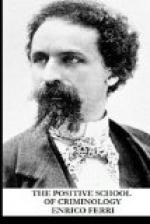The positive school of criminology was inaugurate by the work of Cesare Lombroso, in 1872. From 1872 to 1876 he opened a new way for the study of criminality by demonstrating in his own person that we must first understand the criminal who offends, before we can study and understand his crime. Lombroso studied the prisoners in the various penitentiaries of Italy from the point of view of anthropology. And he compiled his studies in the reports of the Lombardian Institute of Science and Literature, and published them later together in his work “Criminal Man.” The first edition of this work (1876) remained almost unnoticed, either because its scientific material was meager, or because Cesare Lombroso had not yet drawn any general scientific conclusions, which could have attracted the attention of the world of science and law. But simultaneously with its second edition (1878) there appeared two monographs, which constituted the embryo of the new school, supplementing the anthropological studies of Lombroso with conclusions and systematizations from the point of view of sociology and law. Raffaele Garofalo published in the Neapolitan Journal of Philosophy and Literature an essay on criminality, in which he declared that the dangerousness of the criminal was the criterion by which society should measure the function of its defense against the disease of crime. And in the same year, 1878, I took occasion to publish a monograph on the denial of free will and personal responsibility, in which I declared frankly that from now on the science of crime and punishment must look for the fundamental facts of a science of social defense against crime in the human and social life itself. The simultaneous publication of these three monographs caused a stir. The teachers of classic criminology, who had taken kindly to the recommendations of Pessina and Ellero, urging them to study the natural sources of crime, met the new ideas with contempt, when the new methods made a determined and radical departure, and became not only the critics, but the zealous opponents of the new theories. And this is easy to understand. For the struggle for existence is an irresistible law of nature, as well for the thousands of germs scattered to the winds by the oak, as for the ideas which grow in the brain of man. But persecutions, calumnies, criticisms, and opposition are powerless against an idea, if it carries within itself the germ of truth. Moreover, we should look upon this phenomenon of a repugnance in the average intellect (whether of the ordinary man or the scientist) for all new ideas as a natural function. For when the brain of some man has felt the light of a new idea, a sneering criticism serves us a touchstone for it. If the idea is wrong, it will fall by the wayside; if it is right, then criticisms, opposition and persecution will cull the golden kernel from the unsightly shell, and the idea will march victoriously over everything and everybody. It is so in all walks of life—in art, in politics, in science. Every new idea will rouse against itself naturally and inevitably the opposition of the accustomed thoughts. This is so true, that when Cesare Beccaria opened the great historic cycle of the classic school of criminology, he was assaulted by the critics of his time with the same indictments which were brought against us a century later.




